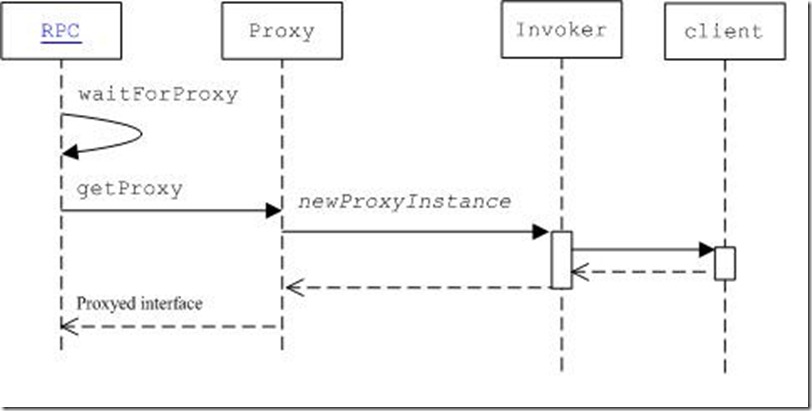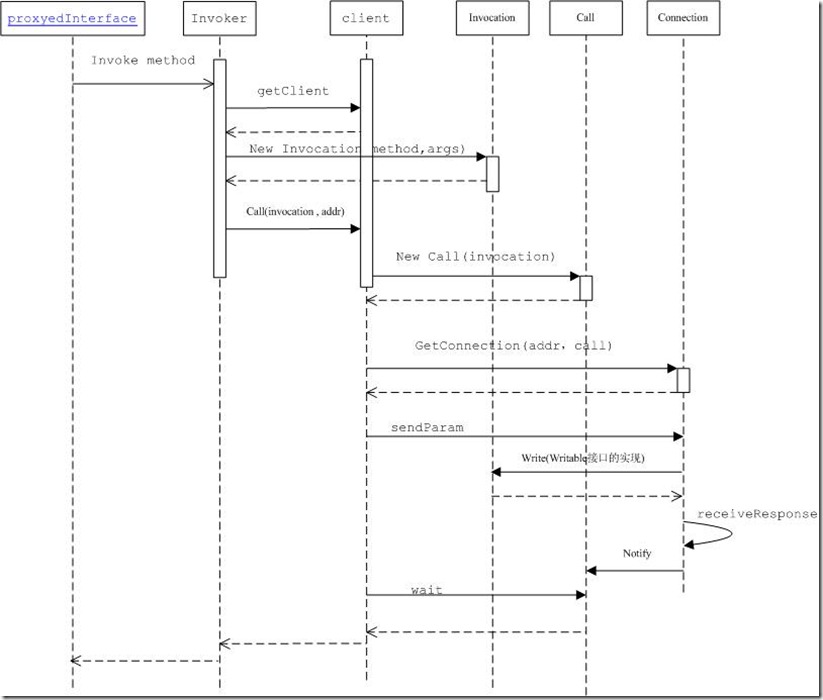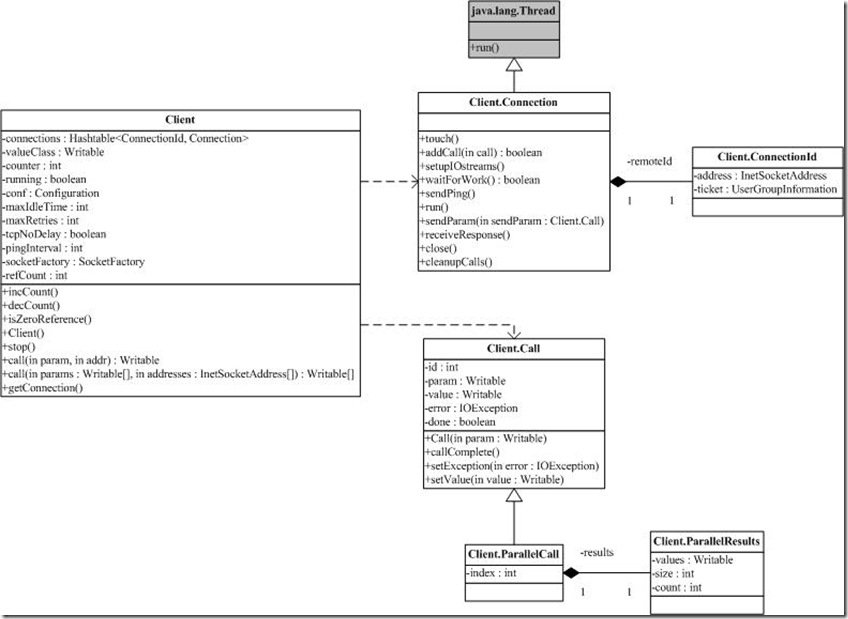[hadoop源码阅读][6]-org.apache.hadoop.ipc-ipc.client
2012-06-21 19:40
489 查看
1.client运行的流程
1)创建代理对象;
2)代理对象调用相应方法(invoke());
3)invoke调用client对象的call方法,向服务器发送请求(参数、方法);
4)再等待call方法的完成;
5)返回请求结果。
2.client主要的内部类
主要的几个类说明:
1. Call,表示一次rpc的调用请求
2. Connection,表示一个client与server之间的连接,一个连接一个线程启动
3. ConnectionId:连接的标记(包括server地址,协议,其他一些连接的配置项信息)
4. ParallelCall:实现并行调用的请求
5. ParallelResults:并行调用的执行结果
3.client调用过程
3.0一个实际的调用
在DFSclient中
3.1生成代理
其中Invoker是一个实现了InvocationHandler 接口的类
3.2代理对象调用相应方法(invoke())
getProxy调用者,使用这个proxy进行任何protocol声明的函数调用,比如还是上例中DFSclient的例子,如果调用proxy.getBlockInfo(…);都会转化成调用Invoker类的invoke函数
Invocation 用于封装方法名和参数,作为数据传输层。远程调用的主要关键就是Invocation实现了Writable接口,Invocation在write(DataOutput out)函数中将调用的methodName写入到out,将调用方法的参数个数写入out ,同时逐个将参数的className写入out,最后将所有参数逐个写入out,这也就决定了通过RPC实现调用的方法中的参数要么是简单类型,要么是String,要么是实现了Writable接口的类(参数自己知道如何序列化到stream),要么是数组(数组的元素也必须为简单类型,String,实现了Writable接口的类)。
Invocation序列化参数的实现是通过如下函数实现的:org.apache.hadoop.io.ObjectWritable.writeObject
3.3invoke调用client对象的call方法,向服务器发送请求(参数、方法)
3.4获得连接对象getConnection
3.5 connection的线程等待接受结果
3.6返回结果,通知client线程
4. 异步/同步模型
Hadoop的RPC对外的接口其实是同步的,但是,RPC的内部实现其实是异步消息机制。hadoop用线程wait/notify机制实现异步转同步,发送请求(call)之后wait请求处理完毕,接收完响应(connection.receiveResponse())之后notify,notify()方法在call.setValue中。但现在有一个问题,一个connection有多个call。可能同时有多个call在等待接收消息,那么是当client接收到response后,怎样确认它到底是之前哪个request的response呢?这个就是依靠的connection中的一个HashTable<Integer, Call>了,其中的Integer是用来标识Call,这样就可以将request和response对应上了。
5.时序图


6.client类图

7.参考
/article/4155476.html
http://www.wikieno.com/2012/02/hadoop-ipc-client/
http://caibinbupt.iteye.com/blog/280790
http://blog.csdn.net/sxf_824/article/details/4842153
http://blog.csdn.net/historyasamirror/article/details/6159248
1)创建代理对象;
2)代理对象调用相应方法(invoke());
3)invoke调用client对象的call方法,向服务器发送请求(参数、方法);
4)再等待call方法的完成;
5)返回请求结果。
2.client主要的内部类
主要的几个类说明:
1. Call,表示一次rpc的调用请求
2. Connection,表示一个client与server之间的连接,一个连接一个线程启动
3. ConnectionId:连接的标记(包括server地址,协议,其他一些连接的配置项信息)
4. ParallelCall:实现并行调用的请求
5. ParallelResults:并行调用的执行结果
3.client调用过程
3.0一个实际的调用
在DFSclient中
return (ClientDatanodeProtocol)RPC.getProxy(ClientDatanodeProtocol.class, ClientDatanodeProtocol.versionID, addr, conf);
3.1生成代理
public static VersionedProtocol getProxy(Class<? extends VersionedProtocol> protocol, long clientVersion, InetSocketAddress addr, UserGroupInformation ticket, Configuration conf, SocketFactory factory, int rpcTimeout) throws IOException
{
……
VersionedProtocol proxy = (VersionedProtocol) Proxy.newProxyInstance(protocol.getClassLoader(), new Class[] { protocol }, new Invoker(protocol, addr, ticket, conf, factory, rpcTimeout));
……
return proxy;
}其中Invoker是一个实现了InvocationHandler 接口的类
3.2代理对象调用相应方法(invoke())
getProxy调用者,使用这个proxy进行任何protocol声明的函数调用,比如还是上例中DFSclient的例子,如果调用proxy.getBlockInfo(…);都会转化成调用Invoker类的invoke函数
public Object invoke(Object proxy, Method method, Object[] args) throws Throwable
{
……
ObjectWritable value = (ObjectWritable) client.call(new Invocation(method, args), remoteId);
……
return value.get();
}Invocation 用于封装方法名和参数,作为数据传输层。远程调用的主要关键就是Invocation实现了Writable接口,Invocation在write(DataOutput out)函数中将调用的methodName写入到out,将调用方法的参数个数写入out ,同时逐个将参数的className写入out,最后将所有参数逐个写入out,这也就决定了通过RPC实现调用的方法中的参数要么是简单类型,要么是String,要么是实现了Writable接口的类(参数自己知道如何序列化到stream),要么是数组(数组的元素也必须为简单类型,String,实现了Writable接口的类)。
Invocation序列化参数的实现是通过如下函数实现的:org.apache.hadoop.io.ObjectWritable.writeObject
public void write(DataOutput out) throws IOException
{
UTF8.writeString(out, methodName);
out.writeInt(parameterClasses.length);
for (int i = 0; i < parameterClasses.length; i++)
{
ObjectWritable.writeObject(out, parameters[i], parameterClasses[i], conf);
}
}3.3invoke调用client对象的call方法,向服务器发送请求(参数、方法)
public Writable call(Writable param, ConnectionId remoteId) throws InterruptedException, IOException
{
Call call = new Call(param);// new Invocation(method, args)
Connection connection = getConnection(remoteId, call);// 获得连接对象 可见一个client可以有多个connection
connection.sendParam(call); // 将Invocation(method, args)的函数名,参数序列化发送到server端
while (!call.done)
{
call.wait(); // wait for the result 调用client的线程在此阻塞
}
return call.value;//返回调用结果
}3.4获得连接对象getConnection
private Connection getConnection(ConnectionId remoteId, Call call) throws IOException, InterruptedException
{
Connection connection;
do
{
synchronized (connections)
{
connection = connections.get(remoteId);
if (connection == null)
{
connection = new Connection(remoteId);
connections.put(remoteId, connection);
}
}
} while (!connection.addCall(call));//可见 一个connection 可以有多个调用call
connection.setupIOstreams();//实际进行连接 每个connection都新起一个线程
return connection;
}3.5 connection的线程等待接受结果
public void run()
{
try
{
while (waitForWork())//超时检测等条件 connection close
{// wait here for work - read or close connection
receiveResponse();
}
}
close();
}
private void receiveResponse()
{
try
{
int id = in.readInt(); // try to read an id
Call call = calls.get(id);
int state = in.readInt(); // read call status
if (state == Status.SUCCESS.state)
{
Writable value = ReflectionUtils.newInstance(valueClass, conf);
value.readFields(in); // 将结果反序列化
call.setValue(value);//在这里
calls.remove(id);
}
} catch (IOException e)
{
markClosed(e);
}
}3.6返回结果,通知client线程
public synchronized void setValue(Writable value)
{
this.value = value;
callComplete();
}
protected synchronized void callComplete()
{
this.done = true;
notify(); // notify caller
}4. 异步/同步模型
Hadoop的RPC对外的接口其实是同步的,但是,RPC的内部实现其实是异步消息机制。hadoop用线程wait/notify机制实现异步转同步,发送请求(call)之后wait请求处理完毕,接收完响应(connection.receiveResponse())之后notify,notify()方法在call.setValue中。但现在有一个问题,一个connection有多个call。可能同时有多个call在等待接收消息,那么是当client接收到response后,怎样确认它到底是之前哪个request的response呢?这个就是依靠的connection中的一个HashTable<Integer, Call>了,其中的Integer是用来标识Call,这样就可以将request和response对应上了。
5.时序图


6.client类图

7.参考
/article/4155476.html
http://www.wikieno.com/2012/02/hadoop-ipc-client/
http://caibinbupt.iteye.com/blog/280790
http://blog.csdn.net/sxf_824/article/details/4842153
http://blog.csdn.net/historyasamirror/article/details/6159248
相关文章推荐
- [hadoop源码阅读][6]-org.apache.hadoop.ipc-ipc.server
- [hadoop源码阅读][6]-org.apache.hadoop.ipc-ipc总体结构和RPC
- [hadoop源码阅读][6]-org.apache.hadoop.ipc-基础知识点(nio,动态代理)
- hdfs.DFSClient: DataStreamer Exception: org.apache.hadoop.ipc.RemoteException: java.io.IOException: 分类: hadoop 2015-03-21 10:56 57人阅读 评论(0) 收藏
- hdfs.DFSClient: DataStreamer Exception: org.apache.hadoop.ipc.RemoteException: java.io.IOException: 分类: hadoop 2015-03-21 10:56 56人阅读 评论(0) 收藏
- [hadoop源码阅读][6]-org.apache.hadoop.ipc-protocol和心跳分析
- hadoop异常:虚拟机上搭建分布式集群org.apache.hadoop.ipc.Client: Retrying connect to server
- hadoop数据节点通信异常【启动hadoop集群遇到错误org.apache.hadoop.ipc.Client: Retrying connect to server】
- hbase错误:Org.apache.hadoop.ipc.RemoteException:User:client is not allowed to impersonate root
- hadoop源码阅读][4]-org.apache.hadoop.io
- [hadoop源码阅读][4]-org.apache.hadoop.io.compress系列1-认识解码器/编码器
- [hadoop源码阅读][4]-org.apache.hadoop.io
- [hadoop源码阅读][4]-org.apache.hadoop.io.compress系列2-选择编解码器
- org.apache.hadoop.ipc.Client: Retrying connect to server异常的解决
- [hadoop源码阅读][4]-org.apache.hadoop.io.compress系列1-认识解码器/编码器
- Hadoop异常 hdfs.DFSClient: DataStreamer Exception: org.apache.hadoop.ipc.RemoteException
- [hadoop源码阅读][4]-org.apache.hadoop.io.compress系列2-选择编解码器
- hadoop遇到的问题: org.apache.hadoop.ipc.Client: Retrying connect to server异常的解决
- [hadoop源码阅读][4]-org.apache.hadoop.io.compress系列3-使用压缩
- org.apache.hadoop.ipc.Client: Retrying connect to server: 0.0.0.0/0.0.0.0:8031
